HONDA ACCORD SEDAN 2000 Owner's Manual (in English)
Manufacturer: HONDA, Model Year: 2000, Model line: ACCORD SEDAN, Model: HONDA ACCORD SEDAN 2000Pages: 329, PDF Size: 4.66 MB
Page 181 of 329
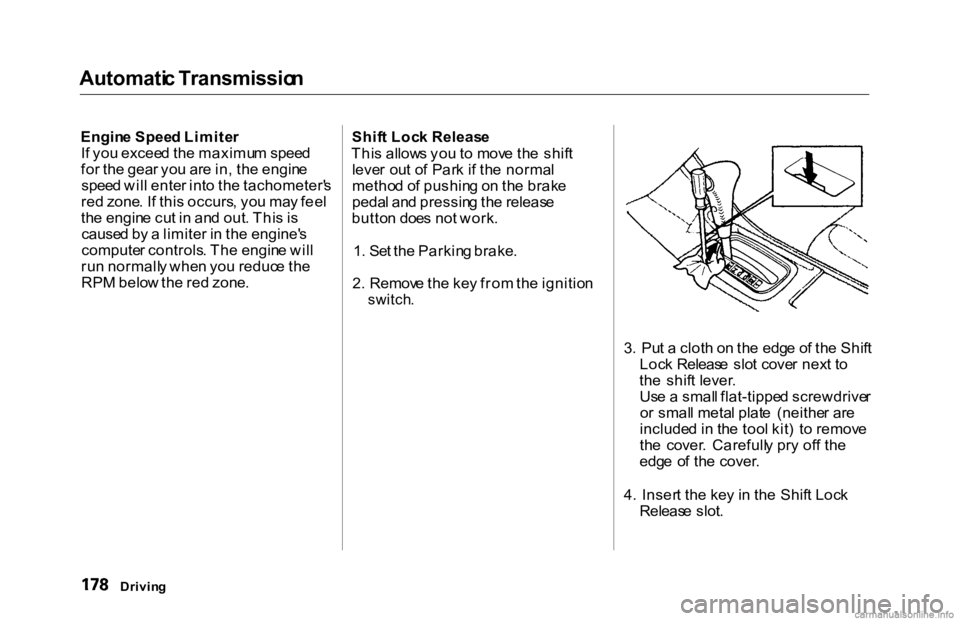
Automati
c Transmissio n
Engin e Spee d Limite r
I f yo u excee d th e maximu m spee d
fo r th e gea r yo u ar e in , th e engin e
spee d wil l ente r int o th e tachometer' s
re d zone . I f thi s occurs , yo u ma y fee l
th e engin e cu t i n an d out . Thi s i s
cause d b y a limite r i n th e engine' s
compute r controls . Th e engin e wil l
ru n normall y whe n yo u reduc e th e
RP M belo w th e re d zone . Shif
t Loc k Releas e
Thi s allow s yo u t o mov e th e shif t
leve r ou t o f Par k i f th e norma l
metho d o f pushin g o n th e brak e
peda l an d pressin g th e releas e
butto n doe s no t work .
1 . Se t th e Parkin g brake .
2 . Remov e th e ke y fro m th e ignitio n
switch .
3. Pu t a clot h o n th e edg e o f th e Shif t
Loc k Releas e slo t cove r nex t t o
th e shif t lever .
Us e a smal l flat-tippe d screwdrive r
o r smal l meta l plat e (neithe r ar e
include d in th e too l kit ) t o remov e
th e cover . Carefull y pr y of f th e
edg e o f th e cover .
4 . Inser t th e ke y i n th e Shif t Loc k
Releas e slot .
Drivin g
Page 182 of 329
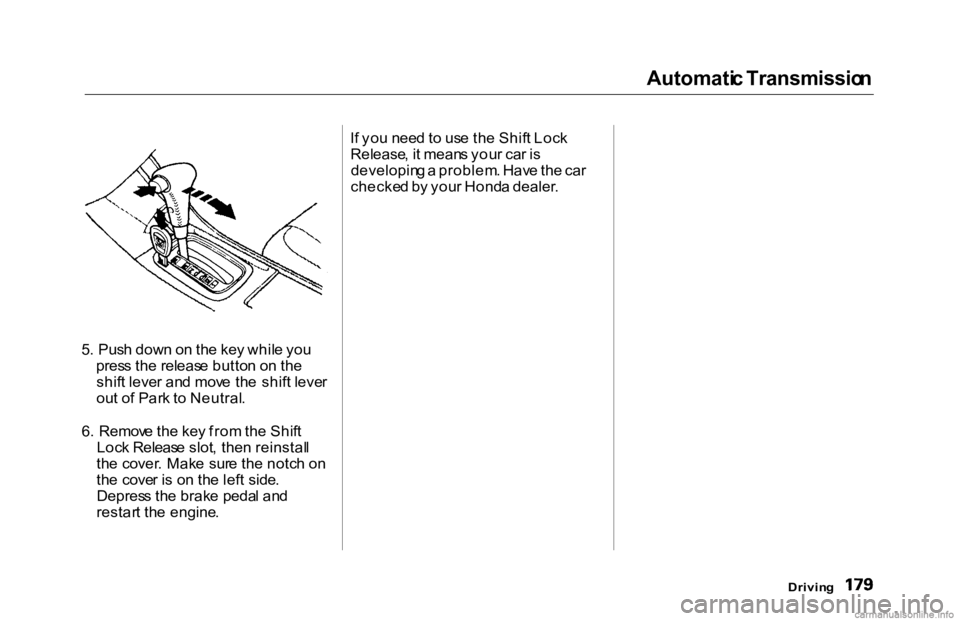
Automati
c Transmissio n
5 . Pus h dow n o n th e ke y whil e yo u
pres s th e releas e butto n o n th e
shif t leve r an d mov e th e shif t leve r
ou t o f Par k t o Neutral .
6 . Remov e th e ke y fro m th e Shif t
Loc k Releas e slot , the n reinstal l
th e cover . Mak e sur e th e notc h o n
th e cove r i s o n th e lef t side .
Depres s th e brak e peda l an d
restar t th e engine . I
f yo u nee d t o us e th e Shif t Loc k
Release , i t mean s you r ca r i s
developin g a problem . Hav e th e ca r
checke d b y you r Hond a dealer .
Driving
Page 183 of 329
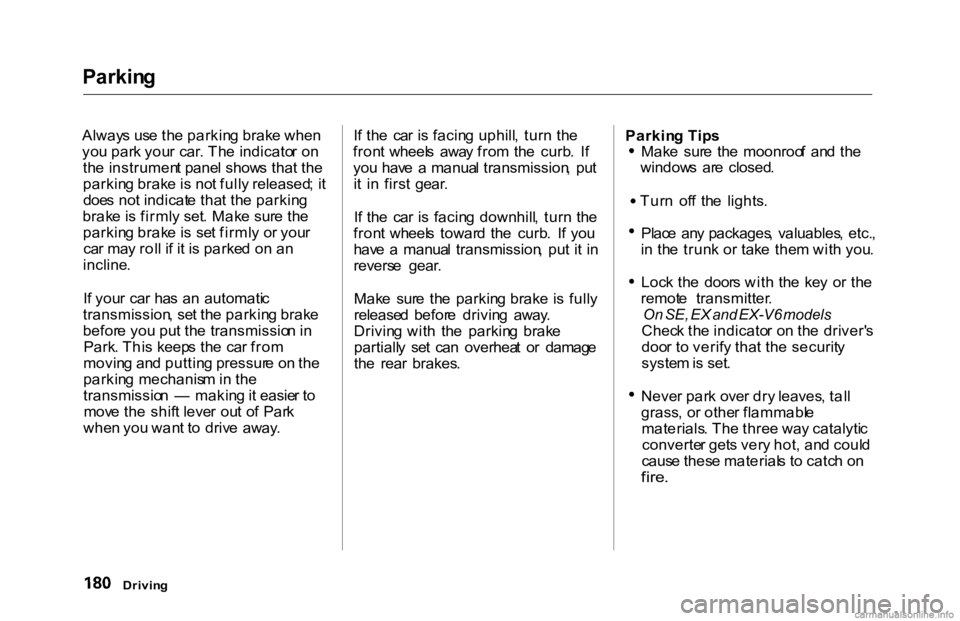
Parkin
g
Alway s us e th e parkin g brak e whe n
yo u par k you r car . Th e indicato r o n
th e instrumen t pane l show s tha t th e
parkin g brak e is no t full y released ; i t
doe s no t indicat e tha t th e parkin g
brak e is firml y set . Mak e sur e th e
parkin g brak e is se t firml y o r you r
ca r ma y rol l i f i t i s parke d o n a n
incline .
I f you r ca r ha s a n automati c
transmission , se t th e parkin g brak e
befor e yo u pu t th e transmissio n in
Park . Thi s keep s th e ca r fro m
movin g an d puttin g pressur e o n th e
parkin g mechanis m in th e
transmissio n — makin g it easie r t o
mov e th e shif t leve r ou t o f Par k
whe n yo u wan t t o driv e away . I
f th e ca r i s facin g uphill , tur n th e
fron t wheel s awa y fro m th e curb . I f
yo u hav e a manua l transmission , pu t
i t i n firs t gear .
I f th e ca r i s facin g downhill , tur n th e
fron t wheel s towar d th e curb . I f yo u
hav e a manua l transmission , pu t i t i n
revers e gear .
Mak e sur e th e parkin g brake is full y
release d befor e drivin g away .
Drivin g wit h th e parkin g brak e
partiall y se t ca n overhea t o r damag e
th e rea r brakes . Parkin
g Tip s
Mak e sur e th e moonroo f an d th e
window s ar e closed .
Tur n of f th e lights .
Plac e an y packages , valuables , etc. ,
i n th e trun k o r tak e the m wit h you .
Loc k th e door s wit h th e ke y o r th e
remot e transmitter .
On SE, EX and EX-V6 models
Chec k th e indicato r o n th e driver' s
doo r t o verif y tha t th e securit y
syste m is set .
Neve r par k ove r dr y leaves , tal l
grass , o r othe r flammabl e
materials . Th e thre e wa y catalyti c
converte r get s ver y hot , an d coul d
caus e thes e material s t o catc h o n
fire .
Drivin g
Page 184 of 329

Th
e Brakin g Syste m
You r Hond a is equippe d wit h fron t
dis c brakes . Th e brake s o n th e rea r
wheel s ma y b e dis c o r drum ,
dependin g o n model . A powe r assis t
help s reduc e th e effor t neede d o n
th e brak e pedal .
Pu t you r foo t o n th e brak e peda l onl y
whe n yo u inten d t o brake . Restin g
you r foo t o n th e peda l keep s th e
brake s applie d lightly , causin g the m
t o buil d u p heat . Hea t build-u p ca n
reduc e ho w wel l you r brake s work . I t
als o keep s you r brak e light s o n al l
th e time , confusin g driver s behin d
you .
Constan
t applicatio n o f th e brake s
whe n goin g dow n a lon g hil l build s
u p hea t an d reduce s thei r effective -
ness . Us e th e engin e to assis t th e
brake s b y downshiftin g to a lowe r
gea r an d takin g you r foo t of f th e
accelerato r pedal .
Chec k you r brake s afte r drivin g
throug h dee p water . Appl y th e
brake s moderatel y t o se e if the y fee l
normal . I f not , appl y the m gentl y an d
frequentl y unti l the y do . Sinc e a
longe r distanc e is neede d to sto p
wit h we t brakes , b e extr a cautiou s
an d aler t i n you r driving . Brak
e Wea r Indicator s
Th e fron t dis c brake s o n al l model s
hav e audibl e brak e wea r indicators .
The y ar e als o o n th e rea r brake s o f
car s equippe d wit h AB S a s standar d
equipment .
Whe n th e brak e pad s nee d replacing ,
yo u wil l hea r a distinctiv e metalli c
"screeching " soun d whe n yo u appl y
th e brakes . I f yo u d o no t hav e th e
brak e pad s replaced , the y wil l begi n
screechin g al l th e time .
You r brake s ma y sometime s squea l
o r squea k whe n yo u appl y the m
lightly . D o no t confus e thi s wit h th e
brak e wea r indicators . The y mak e a
ver y audibl e "screeching. "
Drivin g
Page 185 of 329
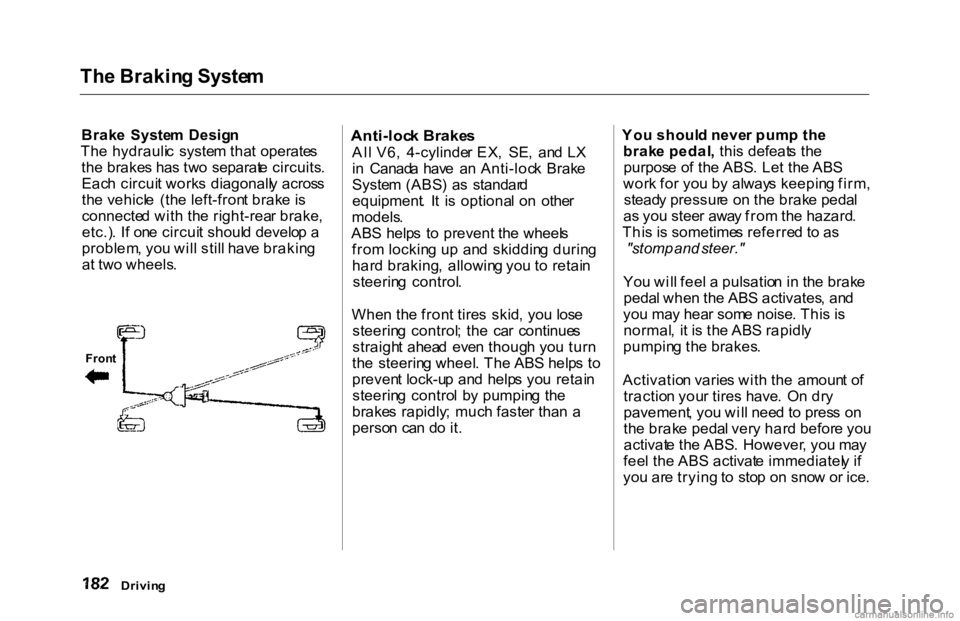
Th
e Brakin g Syste m
Brak e Syste m Desig n
Th e hydrauli c syste m tha t operate s
th e brake s ha s tw o separat e circuits .
Eac h circui t work s diagonall y acros s
th e vehicl e (th e left-fron t brak e is
connecte d wit h th e right-rea r brake ,
etc.) . I f on e circui t shoul d develo p a
problem , yo u wil l stil l hav e brakin g
a t tw o wheels .
Anti-loc
k Brake s
Al l V6 , 4-cylinde r EX , SE , an d L X
i n Canad a hav e a n Anti-loc k Brak e
Syste m (ABS ) a s standar d
equipment . I t i s optiona l o n othe r
models .
AB S help s t o prevent the wheel s
fro m lockin g u p an d skiddin g durin g
har d braking , allowin g yo u t o retai n
steerin g control .
Whe n th e fron t tire s skid , yo u los e
steerin g control ; th e ca r continue s
straigh t ahea d eve n thoug h yo u tur n
th e steerin g wheel . Th e AB S help s t o
preven t lock-u p an d help s yo u retai n
steerin g contro l b y pumpin g th e
brake s rapidly ; muc h faste r tha n a
perso n ca n d o it . Yo
u shoul d neve r pum p th e
brak e pedal , thi s defeat s th e
purpos e o f th e ABS . Le t th e AB S
wor k fo r yo u b y alway s keepin g firm ,
stead y pressur e o n th e brak e peda l
a s yo u stee r awa y fro m th e hazard .
Thi s i s sometime s referre d t o a s
"stomp and steer."
Yo u wil l fee l a pulsatio n in th e brak e
peda l whe n th e AB S activates , an d
yo u ma y hea r som e noise . Thi s i s
normal , i t i s th e AB S rapidl y
pumpin g th e brakes .
Activatio n varie s wit h th e amoun t o f
tractio n you r tire s have . O n dr y
pavement , yo u wil l nee d t o pres s o n
th e brak e peda l ver y har d befor e yo u
activat e th e ABS . However , yo u ma y
fee l th e AB S activat e immediatel y i f
yo u ar e tryin g to sto p o n sno w o r ice .
Drivin g
Fron
t
Page 186 of 329
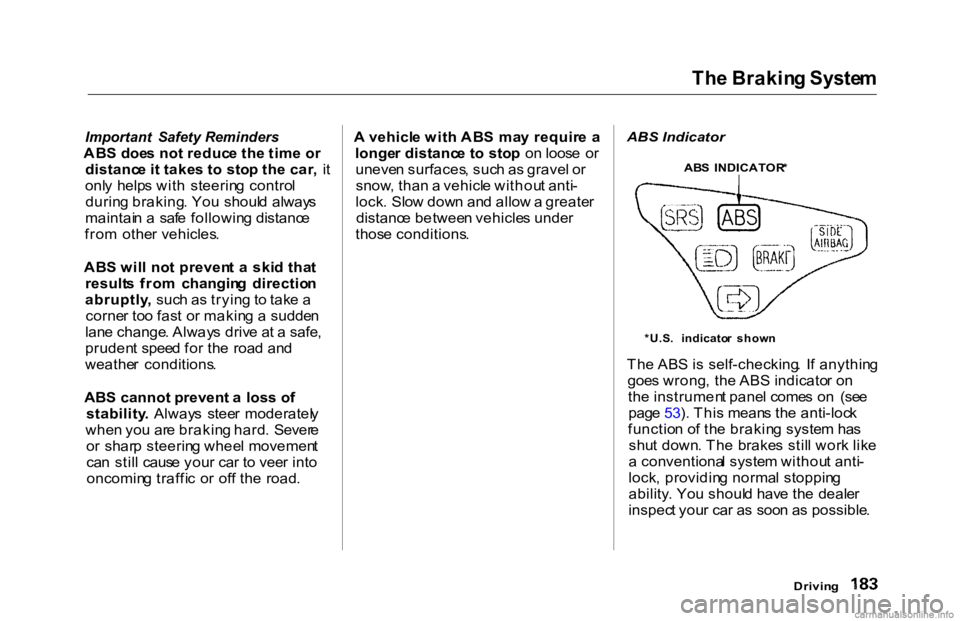
Th
e Brakin g Syste m
Important Safety Reminders
AB S doe s no t reduc e th e tim e o r
distanc e i t take s t o sto p th e car , i t
onl y help s wit h steerin g contro l
durin g braking . Yo u shoul d alway s
maintai n a saf e followin g distanc e
fro m othe r vehicles .
AB S wil l no t preven t a ski d tha t
result s fro m changin g directio n
abruptly , suc h a s tryin g to tak e a
corne r to o fas t o r makin g a sudde n
lan e change . Alway s driv e a t a safe ,
pruden t spee d fo r th e roa d an d
weathe r conditions .
ABS cannot prevent a loss of
stability . Alway s
stee
r moderatel y
whe n yo u ar e brakin g hard . Sever e
o r shar p steerin g whee l movemen t
ca n stil l caus e you r ca r t o vee r int o
oncomin g traffi c o r of f th e road . A
vehicl e wit h AB S ma y requir e a
longe r distanc e t o sto p o n loos e o r
uneve n surfaces , suc h a s grave l o r
snow , tha n a vehicl e withou t anti -
lock . Slo w dow n an d allo w a greate r
distanc e betwee n vehicle s unde r
thos e conditions .
ABS
Indicator
*U.S . indicato r show n
Th e AB S is self-checking . I f anythin g
goe s wrong , th e AB S indicato r o n
th e instrumen t pane l come s o n (se e
pag e 5 3). Thi s mean s th e anti-loc k
functio n o f th e brakin g syste m ha s
shu t down . Th e brake s stil l wor k lik e
a conventiona l syste m withou t anti -
lock , providin g norma l stoppin g
ability . Yo u shoul d hav e th e deale r
inspec t you r ca r a s soo n a s possible .
Drivin g
AB
S INDICATOR *
Page 187 of 329
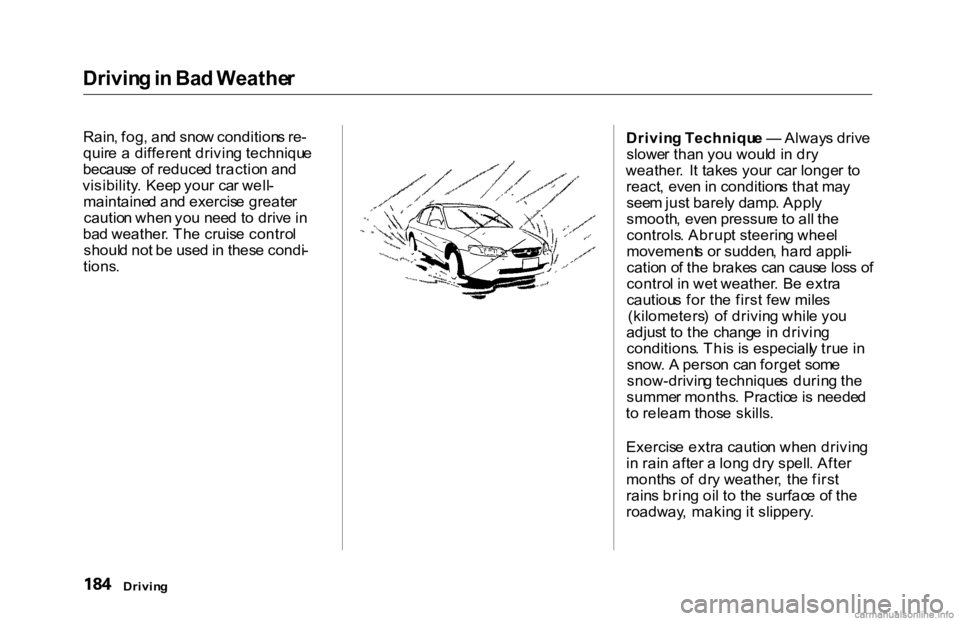
Drivin
g in Ba d Weathe r
Rain , fog , an d sno w condition s re -
quir e a differen t drivin g techniqu e
becaus e o f reduce d tractio n an d
visibility . Kee p you r ca r well -
maintaine d an d exercis e greate r
cautio n whe n yo u nee d t o driv e in
ba d weather . Th e cruis e contro l
shoul d no t b e use d in thes e condi -
tions . Drivin
g Techniqu e — Alway s driv e
slowe r tha n yo u woul d i n dr y
weather . I t take s you r ca r longe r t o
react , eve n in condition s tha t ma y
see m jus t barel y damp . Appl y
smooth , eve n pressur e to al l th e
controls . Abrup t steerin g whee l
movement s o r sudden , har d appli -
catio n o f th e brake s ca n caus e los s o f
contro l i n we t weather . B e extr a
cautiou s fo r th e firs t fe w mile s
(kilometers ) o f drivin g whil e yo u
adjus t t o th e chang e i n drivin g
conditions . Thi s i s especiall y tru e in
snow . A perso n ca n forge t som e
snow-drivin g technique s durin g th e
summe r months . Practic e is neede d
t o relear n thos e skills .
Exercis e extr a cautio n whe n drivin g
i n rai n afte r a lon g dr y spell . Afte r
month s o f dr y weather , th e firs t
rain s brin g oi l t o th e surfac e o f th e
roadway , makin g it slippery .
Drivin g
Page 188 of 329
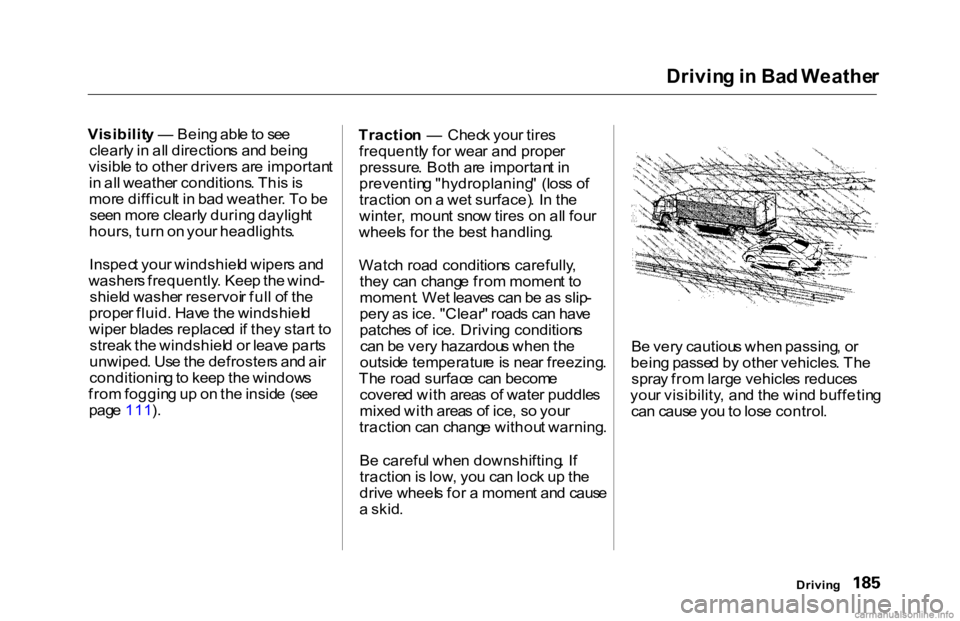
Drivin
g in Ba d Weathe r
Visibilit y — Bein g abl e to se e
clearl y in al l direction s an d bein g
visibl e to othe r driver s ar e importan t
i n al l weathe r conditions . Thi s is
mor e difficul t i n ba d weather . T o b e
see n mor e clearl y durin g dayligh t
hours , tur n o n you r headlights .
Inspec t you r windshiel d wiper s an d
washer s frequently . Kee p th e wind -
shiel d washe r reservoi r ful l o f th e
prope r fluid . Hav e th e windshiel d
wipe r blade s replace d if the y star t t o
strea k th e windshiel d o r leav e part s
unwiped . Us e th e defroster s an d ai r
conditionin g to kee p th e window s
fro m foggin g u p o n th e insid e (se e
pag e 111 ). Tractio
n — Chec k you r tire s
frequentl y fo r wea r an d prope r
pressure . Bot h ar e importan t i n
preventin g "hydroplaning " (los s o f
tractio n o n a we t surface) . I n th e
winter , moun t sno w tire s o n al l fou r
wheel s fo r th e bes t handling .
Watc h roa d condition s carefully ,
the y ca n chang e fro m momen t t o
moment . We t leave s ca n b e a s slip -
per y a s ice . "Clear " road s ca n hav e
patche s o f ice . Drivin g condition s
ca n b e ver y hazardou s whe n th e
outsid e temperatur e is nea r freezing .
Th e roa d surfac e ca n becom e
covere d wit h area s o f wate r puddle s
mixe d wit h area s o f ice , s o you r
tractio n ca n chang e withou t warning .
B e carefu l whe n downshifting . I f
tractio n is low , yo u ca n loc k u p th e
driv e wheel s fo r a momen t an d caus e
a skid . B
e ver y cautiou s whe n passing , o r
bein g passe d b y othe r vehicles . Th e
spra y fro m larg e vehicle s reduce s
you r visibility , an d th e win d buffetin g
ca n caus e yo u to los e control .
Drivin g
Page 189 of 329
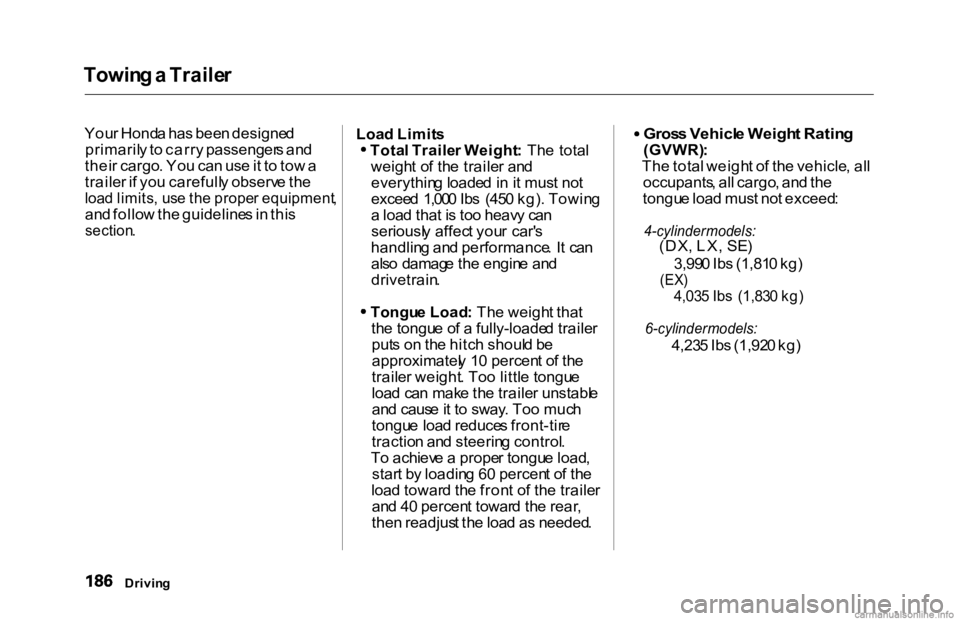
Towin
g a Traile r
You r Hond a ha s bee n designe d
primaril y to carr y passenger s an d
thei r cargo . Yo u ca n us e it t o to w a
traile r i f yo u carefull y observ e th e
loa d limits , us e th e prope r equipment ,
an d follo w th e guideline s in thi s
section .
Loa
d Limit s
Tota l Traile r Weight : Th e tota l
weigh t o f th e traile r an d
everythin g loade d in it mus t no t
excee d 1,00 0 Ib s (45 0 kg) . Towin g
a loa d tha t i s to o heav y ca n
seriousl y affec t you r car' s
handlin g an d performance . I t ca n
als o damag e th e engin e an d
drivetrain .
Tongu e Load : Th e weigh t tha t
th e tongu e o f a fully-loade d traile r
put s o n th e hitc h shoul d b e
approximatel y 1 0 percen t o f th e
traile r weight . To o littl e tongu e
loa d ca n mak e th e traile r unstabl e
an d caus e it t o sway . To o muc h
tongu e loa d reduce s front-tir e
tractio n an d steerin g control .
T o achiev e a prope r tongu e load ,
star t b y loadin g 6 0 percen t o f th e
loa d towar d th e fron t o f th e traile r
an d 4 0 percen t towar d th e rear ,
the n readjus t th e loa d a s needed .
Gros
s Vehicl e Weigh t Ratin g
(GVWR) :
Th e tota l weigh t o f th e vehicle , al l
occupants , al l cargo , an d th e
tongu e loa d mus t no t exceed :
4-cylinder models:
(DX , LX , SE )
3,99 0 Ib s (1,81 0 kg )
(EX )
4,03 5 Ib s (1,83 0 kg )
6-cylinder models:
4,23 5 Ib s (1,92 0 kg )
Drivin g
Page 190 of 329
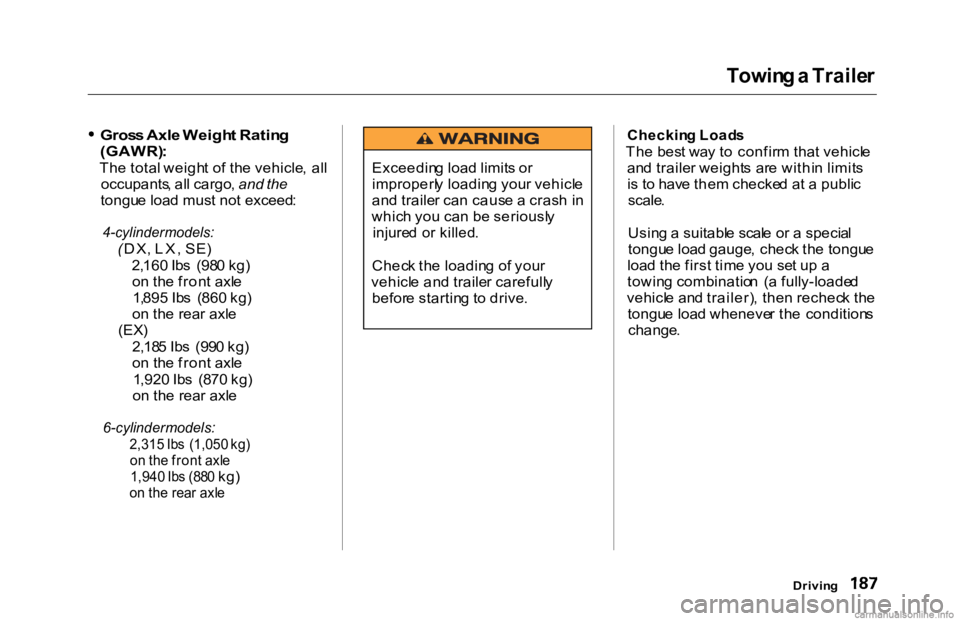
Towin
g a Traile r
Gros s Axl e Weigh t Ratin g
(GAWR) :
Th e tota l weigh t o f th e vehicle , al l
occupants , al l cargo , and the
tongu e loa d mus t no t exceed :
4-cylinder models:
( DX , LX , SE )
2, 160 Ibs (98 0 kg )
o n th e fron t axl e
1, 895 Ibs ( 860 kg)
o n th e rea r axl e
(EX )
2,18 5 Ib s (99 0 kg )
o n th e fron t axl e
1 ,920 Ibs (8 70 kg )
o n th e rea r axl e
6-cylinder models:
2,315 Ib s ( 1,050 kg)
o n th e fron t axl e
1,940 Ibs (88 0
kg )
o n th e rea r axl e
Checkin
g Load s
Th e bes t wa y t o confir m tha t vehicl e
an d traile r weight s ar e withi n limit s
i s t o hav e the m checke d a t a publi c
scale .
Usin g a suitabl e scal e o r a specia l
tongu e loa d gauge , chec k th e tongu e
loa d th e firs t tim e yo u se t u p a
towin g combinatio n ( a fully-loade d
vehicl e an d trailer) , the n rechec k th e
tongu e loa d wheneve r th e condition s
change .
Driving
Exceedin
g loa d limit s o r
improperl y loadin g you r vehicl e
an d traile r ca n caus e a cras h i n
whic h yo u ca n b e seriousl y
injure d o r killed .
Chec k th e loadin g o f you r
vehicl e an d traile r carefull y
befor e startin g t o drive .